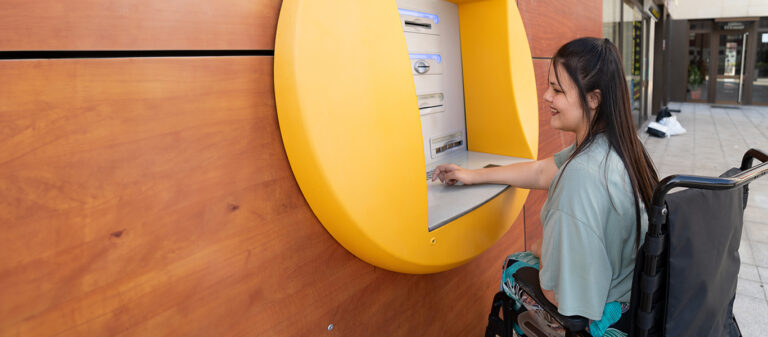What banking fees and charges should I be aware of?
Please rotate your device for the best experience.
Transcript
Banking Charges and Fees
Interactive Video
[A woman inserting her card into an ATM machine.]
Narrator: Banks charge all kinds of fees for one very simple reason, to make money. [Cash comes in from all sides and creates piles next to the bank.] Revenue from fees helps banks keep their operating costs low. [Cash goes into the bank.] After all, banks are businesses and need to cover the costs of the services they provide. [A gear with a dollar sign in the middle is shown with arrows circling it and is labeled “operating costs low.”]
[An advertisement from Bank Life: “Open a free checking account with Bank Life. Visit banklife.com/livefree to learn more.”]
Even if something is advertised as free, chances are fees are built into the account someplace to cover the bank’s costs.
[A man with his hands on his face looking perplexed with a thought bubble that says, “bank fees…”]
But don’t be discouraged by fees. Remember: Financial institutions are a great way to protect and grow your money.
[A woman in thought with a finger on her chin.]
You just have some choices to make. You need to ask yourself: What services do I want? What am I willing to pay for? And what are some ways to avoid fees?
[A computer screen shows an online bank account. The prompt on the computer says, “What type of bank account do you want to open?”]
Some fees are built into the account you select; [a cursor selects “Account Types” and then “Checking” on the laptop screen] they are normally charged monthly, and money is deducted directly from your account. [Coins move from the word “Checking” to an image of a bank with a calendar.]
[The words “bank fees” appear on screen.]
These fees can be charged if you don’t maintain a minimum balance or if you close an account too soon after opening it. A bank may even charge a dormancy fee if you don’t use your account for a long time.
[Picture of a woman inserting her card into an ATM machine.]
A bank also may charge a fee for services you request. The fees are charged when you do something such as use an ATM outside the bank’s network. Some banks even charge a fee if you visit the teller in a bank branch instead of using an ATM, because they want you to use the self-service options they provide. [A woman using a self-service ATM machine outside of the bank appears labeled “no fees.” A woman inside the bank getting cash from a bank teller appears labeled “fees.”
[A man holding a laptop with one hand and typing with the other.]
Researching fees is one part of selecting the right bank account for your needs. Think about your money goals and priorities—they can help you diminish banking expenses.
[Picture of a couple sitting on the couch looking at papers and working in a notebook.]
Read all the documentation you can find about the account types you’re interested in. Your goal is to find a bank that charges the fewest fees at the lowest amounts, with little to no balance or transaction minimums and the most no-cost convenience factors such as free ATM or point-of sale (POS) use. [The list appears: few fees, low fees; little to no minimums; most no-cost convenience factors.]
[Onscreen Text]: Be on the lookout for accounts with these types of fess. Select each card.
Card 1: a required minimum balance (unless you get a better interest rate)
Card 2: a maximum number of transactions in a month
Card 3: debit or credit card, point-of-sale transactions
Card 4: monthly maintenance—essentially a charge for keeping the account open
Card 5: closing an account or not using an account for several months
[A woman working on her computer.]
Don’t kid yourself, though. It’s rare to find a bank that doesn’t have some fees.
[The outside of a bank.]
Fees are usually charged for:
- Using an ATM outside the bank’s network [An ATM machine appears with the label “outside network fee.”]
- Having insufficient funds in an account to pay a check or other debit (also called an overdraft fee) [A declined payment appears with the label “overdraft fee.”]
- Replacing a lost debit, credit, or ATM card, or [Three credit cards appear with the label “lost card fee.”]
- Canceling a check [A check with a “no” symbol over it appears with the label “canceled check fee.”]
Online banks and credit unions tend to charge the fewest and lowest fees.
